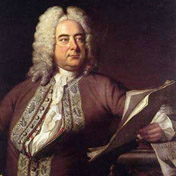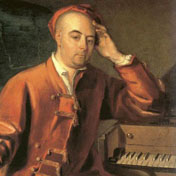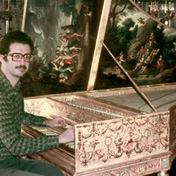Excerpts from this book:
Cover: London: The River Thames with St. Paul's Cathedral on Lord Mayor's Day, c.1747-48,
oil by Canaletto c.1748. (Picture in the Public Domain from ... Wikipedia)
INTRODUCTION
The Daily Courant, first published on 11 March 1702, was the first British daily newspaper. On 19 July 1717 it described a party that had taken place two days earlier, reporting that:
“On Wednesday Evening, at about 8 [pm], The King [George I of Great Britain] took Water at Whitehall in an open Barge ... went up the River towards Chelsea. ... A City Company’s Barge was employed for the Musick, wherein were 50 Instruments of all sorts, who play’d all the way ... the finest Symphonies, compos’d express for this Occasion, by Mr. Hendel: which his Majesty liked so well, that he caus’d it to be played over three times in going and returning. ... At Eleven [pm] his Majesty went a‑shore ... Supper was prepar’d, and then there was another very fine Consort of Musick, which lasted till 2 [am]; after which, His Majesty came again into his Barge, and return’d the same way, the Musick continuing to play till he landed.”
... The Water Music would soon become [Handel's] most celebrated instrumental work, with its remarkable feats of melody, harmony, counterpoint and orchestration. We will review later the interesting history of the Water Music’s orchestral score.
As for arrangements for solo keyboard .... in 1743 ... Walsh issued a harpsichord arrangement .... Unfortunately, ...Walsh 1743 ... in many passages it departs from the original and significantly simplifies the texture, mostly reducing it to a single voice per hand ... Nowadays a few partial keyboard versions can be either heard or read online ... departing considerably from Handel’s score, and we have found it useful to produce a new thorough keyboard arrangement. ...
The present score includes markings meant to reproduce as much as possible the original orchestral dialogs by using a two-manual keyboard instrument, but otherwise the score is fully playable on a single-manual keyboard. Though written mainly with the harpsichord in mind, this arrangement produces excellent effect on the organ, and it includes a few passages with a special separate score for an instrument with a pedalboard. This edition is also perfectly fit for the modern piano, for which we have provided the necessary dynamic directions. ...
I am deeply grateful to Domenico Statuto for his exemplary music typesetting, and to David Pickett for his very helpful editing of the English text. I should like to acknowledge the constructive suggestions of both of them.
THE ORCHESTRAL SCORE
... For the 1717 water party Handel carefully conceived the score to maximise the number of “surprises”, introducing instruments that were not commonly heard in England in this type of “Symphonies”. It is a distinctive possibility that the King was not told about the orchestra composition beforehand. He was in not only for music of a quality unheard of in his time, but also for no less than three surprises:
- After hearing the imposing Overture, the King may well have thought that the full musical evening was to be performed by a large string band plus the customary oboes and bassoons. We may imagine his surprise when, after the second movement “Adagio e staccato” ended in a dominant A major chord, suddenly the orchestra played a vigorous F major chord followed by a triumphant fanfare played by the horns.
- After the Suite in F ended in a dramatic d minor, suddenly the Suite in D was played, a strong initial D major chord being followed by a trumpet fanfare, immediately echoed by the horns.
- It is most likely that during the supper the King and his guests were treated to the Suite in G, where the surprise was produced by the Descant Recorders playing a joyful tune. ...
THE TRANSCRIPTION PROCESS
... The purpose of this edition is to reproduce faithfully—as much as it is possible on the keyboard—the Water Music as conceived and written down by Handel and coincidentally transmitted by the 18th century MS sources. Accordingly, starting from an instrumental score that is universally held among the very best masterpieces of the Baroque era, we have tried to bring every single original note into the present keyboard score: this includes all the top and bottom parts, and as much as possible of the middle voices. Good models are provided by the above-mentioned 20 overtures arranged for the keyboard by Handel himself. ...
KEYBOARD RANGE
The Water Music fits in the chromatic range C-d''' with no C#, covered by most pipe organs both today and in antiquity. The d''' is used very often, and therefore this music is not playable on keyboards that either have a treble going up only to c''' or have a bass C/E short octave. In the extreme treble there is a single e''', playable as e''. ...
TRUMPET SUITE IN D (HWV 349)
...
15. Allegro - Adagio
The trumpets make their “grande entrée”, followed by the horns, while the strings are merely an accompaniment to the brass fanfares. The formal structure is obvious and has to be kept in mind when playing. The movement consists of two sections.
The first section is divided into three subsections, each one consisting of four segments:
- a “Question” on the trumpets (Qt), echoed on the horns (Qh),
- an “Answer” on the trumpets (At), also echoed on the horns (Ah.
We have therefore a very orderly structure: Qt1 Qh1 At1 Ah1 , Qt2 Qh2 At2 Ah2 , Qt3 Qh3 At3 Ah3 .
The second section is a grand finale played by all the orchestra, followed by a 3-bar mysterious Adagio ending in a “question” in F# major, left unanswered, as a preparation for the following movement. ...


